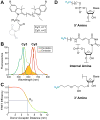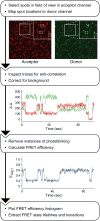Methodologies for studying the spliceosome's RNA dynamics with single-molecule FRET
- PMID: 28529063
- PMCID: PMC5546994
- DOI: 10.1016/j.ymeth.2017.05.011
Methodologies for studying the spliceosome's RNA dynamics with single-molecule FRET
Abstract
The spliceosome is an extraordinarily dynamic molecular machine in which significant changes in composition as well as protein and RNA conformation are required for carrying out pre-mRNA splicing. Single-molecule fluorescence resonance energy transfer (smFRET) can be used to elucidate these dynamics both in well-characterized model systems and in entire spliceosomes. These types of single-molecule data provide novel information about spliceosome components and can be used to identify sub-populations of molecules with unique behaviors. When smFRET is combined with single-molecule fluorescence colocalization, conformational dynamics can be further linked to the presence or absence of a given spliceosome component. Here, we provide a description of experimental considerations, approaches, and workflows for smFRET with an emphasis on applications for the splicing machinery.
Keywords: Dynamics; FRET; Fluorescence; RNA; Single-molecule; Spliceosome.
Copyright © 2017 Elsevier Inc. All rights reserved.
Figures







Similar articles
-
New insights into the spliceosome by single molecule fluorescence microscopy.Curr Opin Chem Biol. 2011 Dec;15(6):864-70. doi: 10.1016/j.cbpa.2011.10.010. Epub 2011 Nov 5. Curr Opin Chem Biol. 2011. PMID: 22057211 Free PMC article. Review.
-
Single-Molecule Pull-Down FRET to Dissect the Mechanisms of Biomolecular Machines.Methods Enzymol. 2015;558:539-570. doi: 10.1016/bs.mie.2015.01.009. Epub 2015 Mar 3. Methods Enzymol. 2015. PMID: 26068753 Free PMC article.
-
Conformational dynamics of stem II of the U2 snRNA.RNA. 2016 Feb;22(2):225-36. doi: 10.1261/rna.052233.115. Epub 2015 Dec 2. RNA. 2016. PMID: 26631165 Free PMC article.
-
Putting Humpty-Dumpty Together: Clustering the Functional Dynamics of Single Biomolecular Machines Such as the Spliceosome.Methods Enzymol. 2016;581:257-283. doi: 10.1016/bs.mie.2016.08.022. Epub 2016 Oct 13. Methods Enzymol. 2016. PMID: 27793282
-
Lights, camera, action! Capturing the spliceosome and pre-mRNA splicing with single-molecule fluorescence microscopy.Wiley Interdiscip Rev RNA. 2016 Sep;7(5):683-701. doi: 10.1002/wrna.1358. Epub 2016 May 20. Wiley Interdiscip Rev RNA. 2016. PMID: 27198613 Free PMC article. Review.
Cited by
-
Dynamics of the DEAD-box ATPase Prp5 RecA-like domains provide a conformational switch during spliceosome assembly.Nucleic Acids Res. 2019 Nov 18;47(20):10842-10851. doi: 10.1093/nar/gkz765. Nucleic Acids Res. 2019. PMID: 31712821 Free PMC article.
-
Approaches for measuring the dynamics of RNA-protein interactions.Wiley Interdiscip Rev RNA. 2020 Jan;11(1):e1565. doi: 10.1002/wrna.1565. Epub 2019 Aug 20. Wiley Interdiscip Rev RNA. 2020. PMID: 31429211 Free PMC article. Review.
-
Biophysical Approaches for the Characterization of Protein-Metabolite Interactions.Methods Mol Biol. 2023;2554:199-229. doi: 10.1007/978-1-0716-2624-5_13. Methods Mol Biol. 2023. PMID: 36178628 Review.
-
Expanding single-molecule fluorescence spectroscopy to capture complexity in biology.Curr Opin Struct Biol. 2019 Oct;58:233-240. doi: 10.1016/j.sbi.2019.05.005. Epub 2019 Jun 15. Curr Opin Struct Biol. 2019. PMID: 31213390 Free PMC article. Review.
-
Optimization and characterization of position-selective labelling of RNA (PLOR) for diverse RNA and DNA sequences.RNA Biol. 2020 Jul;17(7):1009-1017. doi: 10.1080/15476286.2020.1749797. Epub 2020 Apr 19. RNA Biol. 2020. PMID: 32249673 Free PMC article.
References
-
- Moore MJ, Proudfoot NJ. Pre-mRNA processing reaches back to transcription and ahead to translation. Cell. 2009;136(4):688–700. - PubMed
-
- Cech TR, Steitz JA. The noncoding RNA revolution-trashing old rules to forge new ones. Cell. 2014;157(1):77–94. - PubMed
-
- Yan C, Hang J, Wan R, Huang M, Wong CC, Shi Y. Structure of a yeast spliceosome at 3.6-angstrom resolution. Science. 2015;349(6253):1182–91. - PubMed
Publication types
MeSH terms
Substances
Grants and funding
LinkOut - more resources
Full Text Sources
Other Literature Sources

